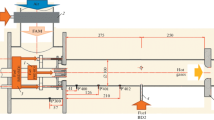Abstract
The combustion characteristics of a low NOx burner using reburning technology have been experimentally studied. The reburn burner usually has three distinct reaction zones which include the primary combustion zone, the reburn zone and the burnout zone by provided secondary air. NOx is mainly produced in a primary combustion zone and a certain portion of NOx can be converted to nitrogen in the reburn zone. In the burnout zone, the unburned mixtures are completely oxidated by supplying secondary air. Liquefied Petroleum Gas (LPG) was used as main and reburn fuels. The experimental parameters investigated involve the main/ reburn fuel ratio, the primary/secondary air ratio, and the injection location of reburn fuel and secondary air. When the amount of reburn fuel reaches to the 20-30% of the total fuel used, the overall NO reduction of 50% is achieved. The secondary air is injected by two different ways including vertical and parallel injection. The injector of secondary air is located at the downstream region of furnace for a vertical-injection mode, which is also placed at the inlet primary-air injection region for a parallel-injection mode. In case of the vertical injection of the secondary air flow, the NOx formation of stoichiometric condition at a primary combustion zone is nearly independent of the reburn conditions (locations, fuel/air ratios) while the NOx emission of the fuel-lean condition is considerably influenced by the reburn conditions. In case of the parallel injection of the secondary air, the NOx emission is sensitive to the air ratio rather than the fuel ratio and the reburning process often coupled with the multiple air-staging and fuel-staging combustion processes.
Similar content being viewed by others
References
Beer, J. M. and Chigier, N. A., 1972, “Combustion Aerodynamics,”John wiley & Sons, inc., pp. 107–117.
Folsom, B. A., Payne, R., Moyeda. D., Vladimir Zamansky and Golden, J., 1995, “Advanced Reburning with New Process Enhancements,” EPRI/EPA 1995 Joint Symposium on Stationary Combustion NOx Control
Lanigan, E. P., Golland, E. S. and Rhine, J. M., 1995. “The Demonstration of Gas Reburning at Longannet : Leading the World in Low-NOx Technology,”Proceedings-International Gas Re- burn Technology Workshop, pp. Dl21–138.
Myerson, A. L., 1974, “The Reduction of Nitric Oxide in Simulated Combustion Effluents by Hydrocarbon-Oxygen Mixtures,”Fifteenth Symposium on Combustion, pp. 1085–1092.
Smart, J. P. and Weber, R., 1989, “Reduction of NOx and Optimisation of Burnout with an Aerodynamically Air-Staged Burner and an Air-Staged Precombustor Burner,”Journal of the Institute of Energy, pp. 237–245.
Smart, J. P. and Morgan, D. J., 1994, “The Effectiveness of Multi-Fuel Reburning in an Internally Fuel-Staged Burner for NOx Reduction,”Fuel, pp. 1437–1442.
Wendt, J.O. L., Sternling, C.V. and Matovich, M. A., 1973, “Reduction of sulfur trioxide and nitrogen oxides by secondary fuel injection,”Fourteenth Symposium on Combustion. pp. 897–904.
Author information
Authors and Affiliations
Corresponding author
Rights and permissions
About this article
Cite this article
Ahn, K., Kim, H., Son, MG. et al. An experimental study on the combustion characteristics of a low nox burner using reburning technology. KSME International Journal 16, 950–958 (2002). https://doi.org/10.1007/BF02949724
Received:
Revised:
Issue Date:
DOI: https://doi.org/10.1007/BF02949724




